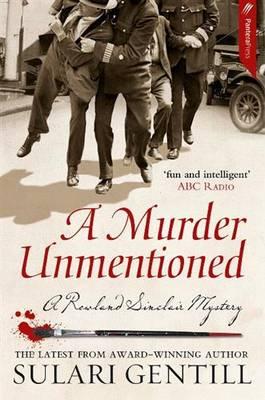Book Review: A Murder Unmentioned, by Sulari Gentill

Here I am again breaking into a series. A Murder Unmentioned (2014) is the sixth in a series set mostly in New South Wales in the 1930s and featuring Rowland Sinclair. Although of course the story is self-contained, a number of the characters and their relationships have obviously been developed in earlier books, and I can’t help thinking that knowing that development might make them seem a bit more real.
Rowland Sinclair is the black sheep of a wealthy family of graziers. He lives an unconventional lifestyle in a mansion in Sydney where he dabbles in painting and takes up left wing causes with three bohemian friends who all seem to be members of the Communist Party. But a visit from the police sends him hurrying back to the family property, Oaklea, near Yass. It seems that his father’s death fourteen years ago, believed to be at the hands of a burglar, isn’t that simple. The reader already knows from the prologue that the burglar story is untrue. But now the gun which killed his father has been found in a dam on the property, along with some items which were believed to have been stolen at the time. So if not a burglar, then who? What motive has a former employee for casting suspicion on Rowland? And why is Rowland so unwilling to talk about it?
I think this novel is best seen as a family saga-cum-historical novel, rather than a crime story. Who killed Father is at the centre of it, but there are lots of family happenings that have only a general relevance to the main game – for example the machinations of Lucy Bennett, the fire at the homestead or Rowland’s sister-in-law Kate’s pregnancy. There is also a lot of material that is included because it is interesting, and of the period. The first chapter sees Rowland taking a flying lesson from Charles Kingsford Smith, with a young Nancy Bird looking on. Everyone’s heard of Kingsford Smith, but some may not know that Nancy Bird was in fact the youngest Australian woman to gain a pilot’s licence. These characters play no further part in the story – though Rowland’s flying does – so why introduce them, other than for historical interest? Rowland goes to a meeting of the NSW Centre Party, and has a run-in with Eric Campbell, who is trying to turn his fascist New Guard movement into a political party – without success, as it happens. Apparently Rowland has crossed swords with Campbell and his New Guard in earlier books, but it has only the most oblique relevance here. Edna Walling is redesigning the gardens at Oaklea, and Jock Garden of the Communist Party, Bob Menzies of the United Australia Party and Frank Green, Sydney gangster, all make an appearance. Each chapter begins with what purports to be an excerpt from a newspaper of the time – though I’m not sure if all of them are genuine. All this historical detail is quite fun, but not really necessary in solving the crime. To put it another way, someone has to find the gun in the dam, but it doesn’t have to be Edna Walling.
Gentill has a fairly formal style of writing. I think this is a deliberate strategy when used in relation to conversations between the characters, where she tries, with some success, to catch the tone of relationships in the 1930’s between men and women, bosses and workers, family members and friends. Thus Rowland says of his painting: ‘My father would not have approved of my work … He would not have tolerated it.’ Or his brother Wilfred: ‘Kate was under the impression you admired her.’ Or Lucy’s father: ‘I knew your father, you know … fine man. I expect you’re cut from the same cloth.’ The 1930s feel is heightened by the similarly of the prose style to the newspaper excerpts. I don’t remember seeing the word ‘chums’ used in ordinary prose since I last read a Girl’s Own Annual. But there are too many clichés, such as ‘his jaw tightened’, ‘his eyes flashed fury’, or ‘his voice was thick with contempt’. Just because run-of-the-mill writers may have used such commonplaces in the 1930s doesn’t mean they should be used now in a book about the 1930s. By all means ensure that Rowland raises his hat to ladies, but don’t let it become a platitude.
I like history, so I found the story fun. There is always something of interest happening. Furthermore, the plot so far as it related to the death of Rowland’s father works well, though I thought the final resolution a bit contrived. If, however, I put on my historian’s hat, I’d have to wonder about the relationship between Rowland and his three friends – two male, one female. Apart from occasionally saying something about capitalist domination, the two men seem to lack the passion and conviction it would have taken to be a Communist. Their relationship seems more like Bunter to Wimsey than comrade to comrade (though Rowland is a fellow-traveller, not a paid up Communist). Putting in a lot of historical detail doesn’t of itself make a book genuinely reflect the history of the times. This is a nice try, rather than the creative reimagining at the heart of the best historical novels.
You can read more about Sulari Gentill and her work here. I love the book’s cover.









1 comment
Login here Register here-
Blanik
Return to home pageWhat about a book review on Kieran Tapsell, 2014, “Poliphar’s Wife: The Vatican’s Secret and Child Sexual Abuse”, ATF Press.
Perhaps with emphasis on The Canon Law. It may give an insight into the thinking on P.M. Abbott and his cabinet’s thinking